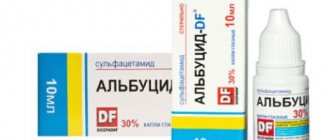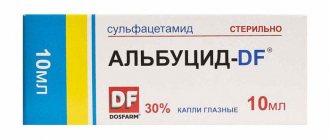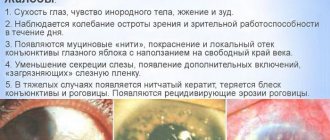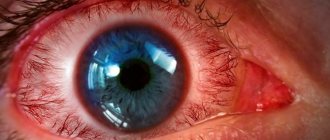Eye diseases can have various forms and manifestations; they occur in people of all ages. Unlike adults, treatment of children, especially the youngest, has its own difficulties and specifics.
One of the most common eye diseases is conjunctivitis. It affects both adults and children. The use of eye drops for conjunctivitis for newborns must correspond to the age of the child, so all parents should know exactly what products can be used for the baby, and what is strictly prohibited.
The main causes of conjunctivitis in children
One of the main causes of conjunctivitis is poor personal hygiene. This happens quite often in children. Pathogenic microorganisms (viruses, bacteria, fungi) enter the conjunctiva (the membrane covering the outside of the eyes) and cause inflammation. The disease can develop against the background of an acute respiratory viral infection, a general weakening of the body due to decreased immunity, injury to the organs of vision, or the entry of a foreign body into them. The most common causes of conjunctivitis include:
- Bacteria. The disease is caused by chlamydia, streptococci, pneumococci, Haemophilus influenzae, and staphylococci. Conjunctivitis caused by bacteria is contagious. Therefore, children attending kindergarten and school are more susceptible to it than others. The bacterial infection is severe and requires long-term treatment. In some cases, antibiotics are prescribed. The illness can last for two weeks.
- Viruses. The most common causes of conjunctivitis are adeno- and enteroviruses. Sometimes viral conjunctivitis becomes a consequence of other diseases: chickenpox, rubella, ARVI, pharyngitis, tonsillitis, influenza. The disease is also contagious and is transmitted through airborne droplets and household routes. The duration of the disease is 5-7 days.
- Allergy. The cause of the disease can be any allergen. This can be dust, chemicals in detergents and cleaning products, pollen, food, medicines and others. It may appear during certain seasons or all the time.
- Injuries. Toddlers and young children, like schoolchildren, are very active. During active games they can injure your eyes. Damage to the mucous membrane sometimes results in conjunctivitis. Even a small grain of sand caught in the eye can injure the thin membrane of the conjunctiva. The child, feeling a foreign body, begins to rub his eyes, thereby causing even greater irritation.
Typically, the disease appears first in one eye and then affects the second. The exception is conjunctivitis caused by allergies. In this case, the pathology manifests itself in both eyes at once.
Different types of conjunctivitis sometimes have the same symptoms. A common symptom of the disease is redness and inflammation of the eyelids.
Other symptoms of the disease include:
- Profuse lacrimation. The child's tears flow all the time for no reason. Tearing becomes worse in bright light.
- Thick discharge. Thick mucus indicates that conjunctivitis is bacterial in nature. As a rule, it is yellowish in color. It happens that this kind of discharge occurs with viral conjunctivitis. If conjunctivitis is caused by an allergy, there is no purulent discharge.
- Itching and irritation. Such signs are characteristic of allergic conjunctivitis.
- Deterioration in general health. The disease is sometimes accompanied by fever, runny nose and throat and nose congestion, increased fatigue, and drowsiness.
In some cases, pain in the eyes and fear of light are added to the main symptoms. Due to the similarity of symptoms, it is quite difficult to determine the etymology of childhood conjunctivitis. Only a specialist can do this. Therefore, at the first signs of illness, you need to make an appointment with a doctor. How to cure conjunctivitis, we will consider below.
Ophthalmic diseases rarely require hospitalization. A child can be admitted to a hospital only if the disease is very advanced or when it comes to the health of a very young patient who requires constant supervision by a specialist. In other cases, the ophthalmologist prescribes home treatment.
To treat conjunctivitis at home with medications, you should get a doctor's prescription. The ophthalmologist will prescribe the necessary medications, after which the children are treated at home.
Before you begin the procedures, you need to know how to treat childhood conjunctivitis. There are no special medicines for children. Conjunctivitis is treated with medications for adults. Therefore, the dosage of the drug is extremely important, as determined by the doctor. Medicines are prescribed according to the type of pathology.
When treating conjunctivitis caused by viruses, drugs that destroy microorganisms are used. The most commonly used: “Ophthalmoferon”. It is a powerful antiviral agent. The medicine relieves itching, redness and pain.
"Aktipol". Eye drops speed up the healing process. Para-aminobenzoic acid in the drug stimulates the synthesis of its own interferon - proteins secreted by the body's cells in response to infection by the virus. Depending on the severity of the disease, it is instilled from three to eight times a day.
"Oftan I'm coming." An antiviral drug that destroys virus cells. The regimen for using the drug has its own characteristics. Buried every hour during the day and every two hours at night. After a while, the drops are used after an hour during the day and after three hours at night. The following drugs will help cure bacterial conjunctivitis in children at home:
- "Albucid". An inexpensive and effective remedy, used for purulent conjunctivitis. Drops are available in different concentrations - 20% and 30%, so they can be used in the treatment of children. May cause side effects - itching and burning, which usually go away quickly.
- "Tobrex". The drug is effective in treating diseases caused by staphylococci, intestinal and Pseudomonas aeruginosa and other harmful microorganisms. Used in the treatment of newborns and infants.
- "Floxal". The product has a wide spectrum of antimicrobial action.
- A positive effect is achieved soon. It is used to treat children of different ages.
- "Levomycetin". Has an active antibacterial effect. Not used in the treatment of children under two years of age.
If a child has allergic conjunctivitis, therapy includes taking local medications and antihistamines. Here are examples of such drugs: “Allergodil”. An effective product with a long-lasting effect - up to 12 hours. Place one drop in each eye morning and evening. In case of exacerbation, the number of doses can be increased to four. Used in the treatment of children over four years of age.
"Lecrolin." Effective antiallergic drops. Quickly reduce the manifestation of allergies, reduce itching and swelling. They have an age limit - up to four years. "Opatanol". It has a long-lasting antiallergic effect; you can limit yourself to taking it twice a day. The drug is prescribed to children over three years of age. “Spersallerg”.
Let us add that in a child, treatment of allergic conjunctivitis begins with the elimination of the allergen that caused the disease. If this is not done, the therapy will be in vain. There are other drugs to treat conjunctivitis in a child. However, they are used only as prescribed by a doctor. The listed medications can also be used in the treatment of conjunctivitis in children at home if prescribed by an ophthalmologist.
Ointments are also effectively used in the treatment of conjunctivitis in children. As with other medications, ointments are used according to the type of disease.
For viral conjunctivitis, the following are often prescribed:
- "Oxolinic ointment." One of the most effective remedies for viral pathologies. The drug is often used in the treatment of children because it has no side effects.
- "Solcoseryl". The ointment accelerates regenerative processes. It includes calf blood dialysis. Shows high results in the fight against viruses.
- "Acyclovir". Effective antiviral ointment. The active components of the drug directly affect the DNA of the virus, as a result of which the virus stops reproducing.
- "Bonafton." The ointment is used for conjunctivitis caused by the herpes virus, as well as for acute forms of mucosal disease.
In the treatment of bacterial conjunctivitis, other antibacterial ointments are used. The most effective of them are: “Tetracycline”. The ointment has low absorption, due to which it has a high therapeutic effect. It also contains a broad-spectrum antibiotic. However, it cannot be used in the treatment of children under eight years of age.
"Erythromycin". A mild antibiotic made from toxins. It is used in the treatment even of infants. Fights pathogens such as gonococci, salmonella, microbacteria, fungi. “Floxal”. The ointment has a wide spectrum of action and high efficiency. Fights many infectious diseases.
Ointments must be applied in a certain way. To apply the drug, you can use a special stick; it usually comes complete with ointment. For the product to work effectively, you must act in the following order:
- wash your hands with soap;
- wash the eyes;
- carefully pull back the lower eyelid and put ointment behind it;
- Massage closed eyes with your fingertips so that the product is well distributed.
Immediately after the ointment gets on the mucous membrane, you may experience discomfort, blurred vision and lacrimation.
In children, proper treatment quickly produces positive results. Your doctor will tell you in detail how to effectively treat conjunctivitis in children at home. Therefore, the first step on the path to recovery should be a visit to a specialist.
In newborns, bacterial conjunctivitis usually develops in the first days of life. The cause of the disease can be various factors. The main pathogenic bacteria are Staphylococcus aureus, Streptococcus and Gonococcus. Most babies become infected with a bacterial form of conjunctivitis during the birth canal. This is often due to:
- congenital diseases of the child;
- disruption of the protective mechanisms of the eyes;
- using unsterile medical instruments;
- failure to comply with hygiene rules;
- weak immunity at birth.
The cause of inflammation can be the presence of infections in the mother of the baby, for example, gonorrhea, an inflammatory process that affects the genitourinary system. The causative agent of this disease is gonococci - gram-negative bacteria. Symptoms of bacterial conjunctivitis often appear in premature babies. The causes of the disease can be maternal pathologies such as:
- sepsis;
- tuberculosis;
- pneumonia;
- streptoderma;
- glomerulonephritis;
- lymphadenitis;
- endocarditis;
- meningitis;
- bronchitis.
Types of disease: bacterial
What drops for conjunctivitis can be used for newborns? Parents often ask this question. However, the answer to this lies only in the competence of the doctor. After all, depending on the type of disease, drops for conjunctivitis are selected for newborns and older children.
Most often, parents are faced with a bacterial type of inflammation of the eye mucosa. Bacteria enter the baby's body due to non-compliance with hygiene rules, which leads to the development of conjunctivitis in a matter of hours. The main symptoms of this type of disease are pus and any other discharge from the eyes, tearing, sticking of the eyelids and pain. In newborn babies, the symptoms are usually most pronounced.
Experts identify several subtypes of bacterial conjunctivitis:
- Chlamydial. Its causative agent is chlamydia bacteria, which cause purulent discharge, redness of the eyes and swelling.
- Pneumococcal. In this case, the disease is characterized by peeling of the films. Often this process is not even accompanied by purulent discharge and swelling of the eyes.
- Blenorheic. This type of conjunctivitis is caused by gonococci. Among ophthalmologists, it is considered the most dangerous for newborns due to the abundance of purulent discharge. In addition, they can cause vision impairment, so you should be very attentive to the baby and his condition when making such a diagnosis.
Bacterial conjunctivitis can also be caused by other bacteria. In such cases, the symptoms of the disease are identical to those already listed.
Where should you start treatment?
Treatment of conjunctivitis in children at home should begin with rinsing. For this purpose, pharmaceutical preparations with disinfecting properties are used. Among them are “Furacilin”, “Miramistin”, “Albucid”. Boric acid and a weak solution of manganese are suitable.
You can prepare the infusion yourself. For this you will need dried herbs. Chamomile is usually used. Its flowers have soothing and anti-inflammatory properties. To prepare the product, pour one tablespoon of chamomile flowers into a glass of boiling water and leave for 15-20 minutes. In the same way, homemade infusions are made from sage, cornflower, and calendula.
If there are no pharmaceutical herbs at hand, black and green tea are used. The tea leaves are mixed in equal proportions. The infusion should not be strong. This rule also applies to other decoctions that are prepared at home. Recipes may contain different amounts of ingredients, so you need to carefully monitor the consistency of the infusion.
The prepared solutions are filtered so that particles of herbs do not get into the child’s eyes.
Aloe will help fight conjunctivitis at home. Use plant juice diluted with boiled water in proportions of one to ten. Aloe juice can also be used as eye drops. Then it needs to be diluted with water in a one to one ratio.
When washing, you should follow a few simple rules:
- before washing, wash your hands thoroughly with soap and cut your nails short;
- It is better to rinse your eyes with liquid at room temperature;
- both eyes are washed even in cases where the symptoms of the disease appear in only one;
- different cotton pads are used for each eye;
- movements are made from the outer corner of the eye towards the bridge of the nose;
- The liquid remaining on the eyes is removed with a clean, dry cloth.
During rinsing, all dried crusts are removed from the eyes if there is purulent discharge. If the cause of eye inflammation is an allergy, then rinsing is not prescribed.
Typically, the course of the disease is accompanied by a high degree of tearing, suppuration, gluing of the eyelids, photophobia, and the appearance of yellow spots on the eyelids. At the same time, insomnia, irritability, acute pain or a feeling of “sand in the eyes” occur. An older child can describe to his parents exactly what he feels, but with infants the situation is more complicated.
If the disease is hidden, then it is almost impossible to understand what exactly is bothering the baby. However, parents need to be aware that for infants, conjunctivitis is a very dangerous disease that can cause irreparable harm to them, so the treatment of conjunctivitis in newborns must be taken very seriously.
Most often in infants, the disease manifests itself within the first day after birth. This is due to an infection of the mother’s birth canal, which was transmitted to the baby during the process of passing through it. Cases of conjunctivitis occurring in strong children born from absolutely healthy mothers are quite common. Such situations are associated with the immune system, which cannot cope with the abundance of bacteria and infections that have entered the baby’s body.
However, regardless of the symptoms, you can very easily get rid of conjunctivitis. For newborns, drops are used for any course of the disease; for older children, ointment can be placed in the eyes. Frequent cases of the disease indicate a decrease in the body's protective functions, so it is necessary to add means to strengthen the immune system to the usual treatment.
What drops for conjunctivitis can be used for newborns? Parents often ask this question. However, the answer to this lies only in the competence of the doctor. After all, depending on the type of disease, drops for conjunctivitis are selected for newborns and older children.
Most often, parents are faced with a bacterial type of inflammation of the eye mucosa. Bacteria enter the baby's body due to non-compliance with hygiene rules, which leads to the development of conjunctivitis in a matter of hours. The main symptoms of this type of disease are pus and any other discharge from the eyes, tearing, sticking of the eyelids and pain. In newborn babies, the symptoms are usually most pronounced.
Experts identify several subtypes of bacterial conjunctivitis:
- Chlamydial. Its causative agent is chlamydia bacteria, which cause purulent discharge, redness of the eyes and swelling.
- Pneumococcal. In this case, the disease is characterized by peeling of the films. Often this process is not even accompanied by purulent discharge and swelling of the eyes.
- Blenorheic. This type of conjunctivitis is caused by gonococci. Among ophthalmologists, it is considered the most dangerous for newborns due to the abundance of purulent discharge. In addition, they can cause vision impairment, so you should be very attentive to the baby and his condition when making such a diagnosis.
Bacterial conjunctivitis can also be caused by other bacteria. In such cases, the symptoms of the disease are identical to those already listed.
The main active ingredient of the product is picloxidine, which effectively and quickly copes with all the symptoms of the disease and neutralizes its pathogens. After the first use, dryness and irritation are relieved, and after a full course of treatment, you can forget about conjunctivitis for a long time.
You need to drip the product two to six times a day for no longer than ten days. Typically, one drop of Vitabact is recommended in each eye. Judging by the reviews of drops against conjunctivitis for newborns, this drug still has a number of disadvantages. Among them, parents highlight a short shelf life. After opening, the drug retains its properties for no longer than one month. And the price of Vitabact is extremely high for many - from four hundred rubles per bottle.
Parents consider the main advantage of the product to be well tolerated by infants. They are not capricious during treatment, since the drops do not cause discomfort in the form of itching, burning and irritation. Therefore, most often for bacterial conjunctivitis, the doctor prescribes this particular drug. However, he is far from the only one.
All parents have known well and for a long time such a remedy as “Albucid”. Is it possible to give Albucid to children under one year of age? This question is quite reasonable, considering that the drops cause pain, itching and severe irritation as a side effect. Despite these symptoms, the drug is widely used in the treatment of bacterial conjunctivitis in infants, children and adults.
The drug is an aqueous solution of sulfacytamide. Depending on age, different concentrations are used. For newborns, a 10% solution is sufficient, which is instilled four to six times a day, one or two drops into each eye. This medicine is often prescribed to infants for the prevention of blenorrhea.
Often, with a bacterial infection, the doctor prescribes drops for conjunctivitis for children with an antibiotic. “Fucitalmic” performed well in this group. However, for newly born infants, this remedy is prescribed with great caution. It is a viscous suspension, which provides a long-term effect after one instillation.
The active ingredient of the product is fusidic acid (this is indicated in the instructions for Fucithalmic eye drops for children). Parents leave quite good reviews of the treatment with this remedy. Judging by them, you can find out that the average course of treatment lasts one week. It is enough to drop the drug twice a day. At the same time, positive dynamics are noted already in the first days of using the drops.
Mothers call another effective drops for conjunctivitis for newborns - “Tobrex”. For older children, you can use it in the form of an ointment, but only drops are prescribed for infants. The active ingredient of the drug is tobramycin, which is absolutely safe for children of any age. Typically, the course of treatment does not exceed one week; the product should be dripped every four hours. Mothers consider Tobrex very effective and often purchase it, despite the price of three hundred rubles.
Doctors distinguish the following types of viral conjunctivitis:
- Adenoviral. The adenovirus that causes the disease appears on the mucous membrane of the eye as films and an abundance of small bubbles on the inside of the eyelids. Typically, among the main symptoms, the most alarming are headache, chills and high fever.
- Diphtheria. This type of conjunctivitis often affects infants and children under one year old. It is provoked by the diphtheria bacillus, and infection occurs by airborne droplets. Inflammation is characterized by symptoms such as fever, bleeding, and enlarged lymph nodes.
- Herpetic. The symptoms characteristic of all types of conjunctivitis in this case are supplemented by watery blisters.
Children are often prescribed drops such as Actipol. They have a very wide spectrum of action and are therefore often used to treat newborns. In addition to getting rid of the symptoms of conjunctivitis, according to ophthalmologists, the drops promote the regeneration of corneal tissue, which is very important when it comes to very young patients.
The difficulty in diagnosing the disease in infants lies in the inability to identify the irritating substance. Therefore, even if allergic conjunctivitis appears in a baby, doctors will only be able to determine its cause at an older age. This fact influenced the list of drugs for the treatment of this type of conjunctivitis; almost all of them can be used by children aged two years and older.
Remember that any treatment regimen involves frequent treatment of the mucous membranes of the child’s eyes.
- Before instilling the selected drug, thoroughly clean the eyes of secretions and rinse.
- Administer the required amount of medication, strictly following the dosage prescribed by the doctor.
- It is necessary to bury both organs of vision, even if one of them is completely healthy.
- Do not put a bandage on a sore eye. Otherwise, the risk of further development of pathogens and injury to the delicate skin of the eyelids increases.
Drops for bacterial conjunctivitis
If an infection of a bacterial nature is detected, infants are prescribed:
- Albucid.
- Fucithalmic.
- Vitabact.
- Phloxal.
Albucid is produced on the territory of the Russian Federation. The active substance of this product is sulfacetamide. The drug is prescribed to infants with inflammation of the conjunctiva who have normal tolerance to its composition. The cost of the medicinal liquid is low - from 80 rubles.
Fucithalmic is an Irish remedy that comes in the form of a viscous suspension. The drug contains fusidic acid, which has a wide spectrum of antibacterial activity. The medicine is well tolerated and can be used at any age. You can purchase this product for 350 rubles.
Vitabact is a Swiss eye instillation product based on picloxidine. In addition to pathogenic bacteria, the drug also has a detrimental effect on some viruses and fungi. The average price of the solution is 380 rubles.
Floxal is a German product with ofloxacin, which effectively eliminates gram-positive and gram-negative pathogenic microflora (except for Enterococcus spp., which are resistant to this drug). The drug for eye drops has an affordable price - from 140 rubles.
In some cases, Levomycetin is prescribed for bacterial conjunctivitis. It is advisable to use this remedy no earlier than 6 months.
Yoga for varicose veins: a set of exercises, contraindications
The changes that occur to the walls of blood vessels and their valves are irreversible! The only way to get rid of varicose veins is surgery. Performing asanas is an excellent preventive way to prevent this pathology, and if it has already developed, then with their help you can significantly slow down the progression of the disease and reduce the level of discomfort in the legs.
Special exercise therapy and yoga complexes for varicose veins are definitely recommended, but not for everyone. It should be immediately clarified that asanas help, but only to a certain extent, and in this case you will have to be in a position with your feet up and/or without movement for quite a long time. If the vascular valves are already weakened, then yoga will help only while performing asanas and no more.
Since Yoga is a type of physical exercise, there are a number of contraindications for it, which require consultation with your doctor:
- exacerbation of chronic diseases of internal organs;
- an attack of increased blood or intracranial pressure;
- hypertension stage II-III;
- pain in any part of the body or organ;
- the first six months after a heart attack or stroke;
- severe diseases of the heart and cardiovascular system;
- increased body temperature;
- acute period of illness of any etiology;
- inguinal, abdominal and intervertebral hernias;
- severe traumatic brain injury and spinal injury;
- menstruation, pregnancy, the first 3 months after childbirth;
- arthrosis;
- oncology;
- mental illness, tendency to psychosis.
Moreover, each asana has its own contraindications. Below, where the exercises that are included in the Yoga for varicose veins complex will be described, they will definitely be mentioned.
Yoga classes can not only benefit the body, but also cause harm, since in some pathologies it is contraindicated to perform even simple asanas.
Yoga for varicose veins - contraindications:
- tendency to form blood clots;
- joint and bone injuries;
- the presence of acute inflammatory processes, malignant neoplasms; in organism;
- hernia;
- recent heart attack, stroke, serious heart disease;
- mental disorders other than depression;
- advanced stages of varicose veins;
- a relative contraindication is hypertension; if you have high blood pressure, you cannot do inverted asanas.
Yoga cannot always be practiced during pregnancy and within 3-4 months after the birth of the child; you must additionally consult with a gynecologist.
Brief information about the treatment of conjunctivitis
The ophthalmologist draws up a treatment regimen taking into account the severity of the disease and the age of the child. Before prescribing any medicine, the patient will need to undergo a series of examinations to identify the causative agent of the disease or allergen in the body.
When the first signs of conjunctivitis appear, each visual organ is treated separately with a sterile gauze cloth soaked in an antiseptic. This should be done in the direction from the outer corner of the eyes to the inner.
If it is not possible to see a doctor in the near future, then the child needs to wash his eyes with chamomile decoction, strong tea leaves or furatsilin solution, dissolving 1 tablet in 200 ml of warm boiled water.
How to put eye drops
Next, perform the following steps:
- Place the child on a flat surface. If the newborn shows increased activity, it is better to swaddle him before the procedure.
- Gently pull back the baby's lower eyelid until the conjunctiva becomes visible.
- Introduce the required number of drops, avoiding touching the mucous membrane of the eye or eyelashes with the dropper or pipette (if sterility is lost, you will need to buy a new solution).
- Close the eyelid and remove any remaining medicinal liquid using a clean cotton pad.
- Repeat the manipulations with the second eye, strictly following the correct algorithm for the procedure.
- Place the drops for storage in compliance with all the conditions indicated in the instructions (after opening, most drugs can be used for 3-4 weeks).
If a child is prescribed several eye drops at once, wait at least 15 minutes between administration of each solution.
Dosages of ophthalmic solutions used in the treatment of childhood conjunctivitis are determined by the doctor individually. In most cases, 1-2 drops are injected into each organ of vision at a time.
The minimum frequency of instillation of medications for conjunctivitis is once or twice a day. If a young patient has an acute infectious process, medications can be administered up to 6-8 times during the day.
Before using any ophthalmic solutions to combat conjunctivitis in infants, it is necessary to show the baby to a doctor and obtain a medical prescription. Self-medication in such a situation should be completely excluded. The results of uncontrolled therapy may be a deterioration in the condition of a small patient or the development of undesirable complications.
Drops for viral conjunctivitis
The viral form of the pathology often occurs against the background of colds (ARVI, influenza). With such a violation, severe lacrimation and discomfort occur. There is no purulent discharge in the eye area.
If a baby has confirmed viral conjunctivitis, the following types of eye drops are used:
- Aktipol;
- Oftalmoferon;
- Interferon.
Actipol is a drug that stimulates the production of interferon in the human body. The product contains aminobenzoic acid and is produced in Russia. The solution helps relieve swelling, regulates the water-salt balance, and accelerates the healing of the affected cornea. You can buy this medicine for 150 rubles.
Ophthalmoferon is a domestic pharmacological product that combines recombinant interferon alpha-2b and diphenhydramine. The drug has an antiviral and immunomodulatory effect, accelerates the regeneration of the cornea of the eyeball. The price of drops in most pharmacies in the Russian Federation does not exceed 300 rubles.
Interferon, produced by Russian pharmacists, is in the form of a powder for preparing a solution. The product is intended to combat a variety of viruses that affect the eye structures, increase local immunity, and effectively prevent relapse. You can purchase this drug in a pharmacy chain for 120-140 rubles.
Reviews about the drugs
What do mothers say about medications for conjunctivitis?
Lena:
We had conjunctivitis, and we used chloramphenicol drops. My friends tried to dissuade me, but I listened to the doctor’s advice and did not regret it. The swelling quickly went away and the disease subsided.
Hope:
Suppuration of the eyes began while still in the hospital. The doctor advised rinsing them with furatsilin solution and placing erythromycin ointment behind the eyelid. As a result, the suppuration went away in literally 1 day. I am pleased!
Irina:
For conjunctivitis, a solution of furatsilin and Tobrex was prescribed. They used it strictly according to the scheme, even though the pharmacy “intimidated” us quite a bit, saying that the drops were very strong. I don’t know if it’s true, but there were no side effects, everything went away in a matter of days.
You can learn more about this disease by watching Dr. Komarovsky’s video:
Conjunctivitis is an unpleasant but completely curable disease. Several dozen drugs have been developed to combat it. Write them down and let your family and friends know them by simply sharing this article.
And also subscribe to our updates and stay up to date with the news! See you later!
Currently reading:
Treatment tips
- Before using any medications, the baby’s eyes are washed with chamomile decoction or furatsilin solution.
- Even if conjunctivitis affects only one eye, both need to be treated and instilled. The second is for prevention.
- Under no circumstances should you cover your baby's eyes with a blindfold. It will create excellent conditions for the growth of bacteria and will only worsen the situation.
Rules of application
In addition to the fact that the selection of medications must be made taking into account the characteristics of this type of conjunctivitis, it is imperative to follow the instructions and recommendations of doctors. In severe cases, treatment can take up to two weeks and be reduced to two to five days if you consult an ophthalmologist in a timely manner.
Antihistamines and anti-inflammatory drugs are usually used two to three times a day, placing one or two drops in each eye.
The use of antibacterial drops can be up to six to eight times a day, two to three drops. The duration of treatment depends on the size of the inflamed area, the process ends with its complete disappearance.
Antifungal agents are prescribed and used taking into account the age, condition and individual characteristics of the patient.
Antibiotics can be used to treat inflammation of the conjunctiva for up to eight to fourteen days, depending on the stage and characteristics of the virus. The frequency of administration is up to eight times a day, two drops in each eye. After the condition improves, the dosage is reduced.
Toric lenses - what are they?
Lenses for a month: this article will tell you which ones are best.
Eye lenses for 3 months https://eyesdocs.ru/linzy/dlitelnogo-nosheniya/osobennosti-i-specifika-rezhima-nosheniya.html











